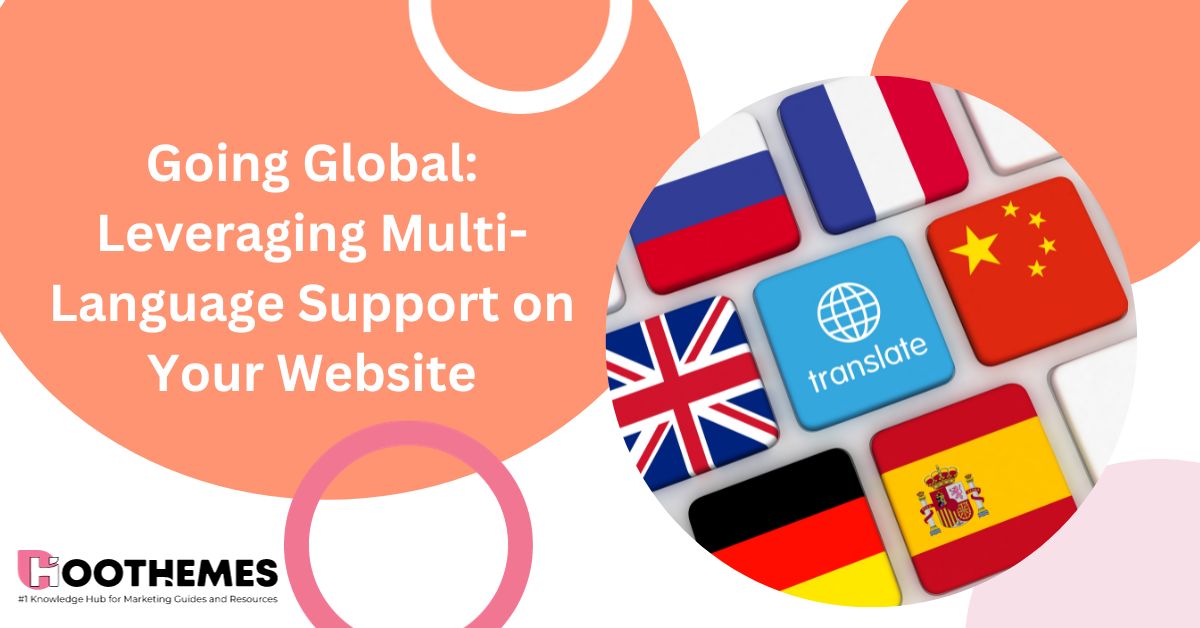Are you wondering whether you should utilize multi-language support on your website? Here’s why you need it: Businesses are no longer confined to local or regional boundaries. With the click of a button, your website can reach audiences from every corner of the globe.
While the internet has made global reach easier, there’s a crucial element that many businesses overlook: language. So this is where the power of multi-language support comes into play.
By offering content in multiple languages, not only do you make your website accessible to a broader audience, but you also build trust, increase your brand awareness, and tap into markets that were previously out of reach.
So in this blog post, we’ll delve into the importance of leveraging multi-language support on your website, the potential growth it can bring, and how to effectively implement it.
Whether you’re a small business or a large enterprise, going global with multi-language support can be a game-changer for your online presence.
Let’s get into it.
What Exactly Multi-Language Support means
Let’s start with a simple question: If you had a physical store, would you turn away customers just because they spoke a different language? Probably not. You’d find ways to communicate, maybe even hire multilingual staff. So, why should your online store be any different?
Graham Grieve, Scottish Travel Blogger at My Voyage Scotland, says, “Many businesses operate under the assumption that English is the ‘universal’ language of the web. And while it’s true that a significant portion of online content is in English, it’s a mistake to think that everyone prefers to browse in English.”
For instance, did you know that while there are over 1.2 billion English speakers worldwide, only about 360 million of them are native speakers? That leaves a vast majority who might understand English but would feel more comfortable in their native tongue.
Let’s take China as an example. With its booming economy and a vast population of internet users, it’s a goldmine for businesses to monetize their websites. But here’s the catch: the majority of Chinese internet users prefer content in Mandarin.
By not offering a Mandarin version of your website, you’re potentially missing out on reaching a significant portion of over 800 million internet users!
Benefits of Utilizing Multi-language Support
Without further ado, let’s delve into the benefits of having multi-language support on your website:
#1 There’s a Rise of Other Languages in the Digital Space
The linguistic diversity is expanding. Spanish, for instance, is the second most spoken language online, with over 300 million users. Then there’s Arabic, a language that has seen a whopping 2500% growth in its online presence since 2000. And we can’t forget Hindi, Russian, Portuguese, and many others that are steadily carving out their space on the web.
When asked about it, Sam McKay, CEO of Enterprise DNA, puts it this way, “Imagine being a Spanish speaker and stumbling upon a tech website that offers reviews in both English and Spanish. You’d naturally gravitate towards the Spanish content, right? It’s not just about understanding; it’s about comfort, trust, and relatability.”
Expanding your website to multi-language support is a strategic move. It’s about acknowledging the global nature of the internet and ensuring that language isn’t a barrier but a bridge to reaching a wider audience.
#2 You Build Trust with Multi-Language Support
Imagine you’re traveling abroad, and you walk into a local cafe. The menu is in a language you don’t understand, and you struggle to figure out what to order. Then, a waiter comes over and hands you a menu in your native language.
Instant relief, right?
That simple act of providing a menu in a language you understand immediately enhances your experience and makes you feel valued.
The same principle applies online.
As Eric Eng, CEO and Founder of AdmissionSight, “When visitors land on your website and find content in their native language, it creates an instant connection. They feel understood, valued, and catered to. It’s like walking into a foreign store, and finding someone who speaks your language.”
The browsing experience becomes smoother, questions are answered more clearly, and the user feels more at home.
Moreover, a website in a user’s native language can reduce misunderstandings and misinterpretations about products or services. It ensures that the message you want to convey is the message that’s received.
#3 Purchase Rate Goes Up…Significantly
Brandon Armstrong, CEO of Quinable Inc, says, “Trust is a significant factor in purchasing decisions. When customers trust a brand, they’re more likely to buy from it, recommend it to others, and come back for more.”
And one of the quickest ways to build that trust? Speak their language.
Studies have shown that customers are more likely to purchase a product online if the information is presented in their language.
In fact, a report by Common Sense Advisory found that 72.4% of consumers are more likely to buy a product with information in their own language.
Moreover, 56.2% of the respondents said that having information in their native language is even more important than price.
Think about that for a moment.
Over half of the consumers surveyed would choose a product with information in their language over a cheaper alternative. That’s the power of multi-language support.
“When customers feel that a brand has made an effort to cater to their linguistic preferences, it fosters loyalty. They’re not just buying a product or service; they’re buying an experience, an understanding.”, says Khashayar Shahnazari, Chief Executive Officer at FinlyWealth.
And when they have a positive experience, they’re more likely to return, leading to higher repurchase rates.
#4 You Rank Better on Search Engines like Google
Search Engine Optimization (SEO) isn’t just about keywords and backlinks; it’s about delivering a user experience that search engines deem valuable. And what’s more valuable than providing content in a user’s preferred language?
Here’s a case study by Holistic SEO – their organic traffic has grown by 425% in just 6 months with a multilingual approach.
As Martin Seeley, CEO of Mattress Next Day, says, “When you offer multi-language support, you’re essentially creating multiple versions of your website tailored to different linguistic audiences. This means you can target keywords specific to each language, tapping into new search queries and reaching audiences that your monolingual competitors might be missing.”
For instance, a tech website might rank well for “best smartphones 2023” in English. But what about the Spanish equivalent “mejores smartphones 2023” or the French “meilleurs smartphones 2023”?
By having content optimized for these terms, you can capture a broader audience, and drive more organic traffic to your site.
Moreover, search engines prioritize user experience. If a Spanish speaker clicks on your website and quickly leaves because the content is only in English, it sends a negative signal to search engines about the relevancy and quality of your site for that user.
However, if they land on a Spanish version of your site, spend time browsing, and engage with the content, it sends a positive signal about the user experience you’re providing.
How to Set Up Multi-Language Support on Your Site
The digital age has seen businesses shifting online, aiming to cater to a global audience. As the demand for online shopping surges, the need for multilingual websites becomes more evident.
WordPress, being one of the most popular platforms for website creation, has recognized this need and offers various tools to make your website multilingual.
There are two primary ways to achieve this:
- Dynamic Website Translation Tools: These are tools like TranslatePress that provide instant translations on top of any website. While they offer quick translations, they don’t make the website inherently multilingual. The original site remains in a single language, with translations layered on top for the current visit.
- True Multilingual Websites: These are websites where the content itself is available in two or more languages. The website owner or their team provides multiple page versions for each language they want to cater to. This approach ensures higher translation quality as it doesn’t solely rely on machine translation.
With WordPress, creating a true multilingual website is straightforward, thanks to plugins like TranslatePress. This plugin offers an intuitive visual interface, allowing you to translate all your website content in minutes.
Also Read: How to Create a Website: Best Guide to Informative Online Presence
How to Implement Multi-Language Support in WordPress
1. Set Up Your WordPress Site: Begin with a single-language WordPress site design. Once set up, you can customize and add content.
2. Install TranslatePress: This plugin manages all your website translations. It’s available in both free and premium versions. After installation, you can add secondary languages from the settings.
3. Automatic Translation (Optional): For larger websites, automatic translation can save time. TranslatePress allows integration with Google Translate or DeepL for this purpose.
4. Translate Your Content: Using the visual translation editor in TranslatePress, you can manually translate or proofread automatically translated content.
5. Customize the Language Switcher: Ensure that the language options are easily accessible to visitors. TranslatePress offers various customization options for the language switcher.
Multi-Language Support Challenges
While it’s great to have multiple languages on your site, catering to users from different countries. There are two main things you need to take care of:
Differentiating Between Multilingual and Multi-regional Sites
“Multilingual sites offer content in multiple languages, while multi-regional sites target users in different countries or regions. It’s essential to understand this difference as SEO strategies might vary.”, points out Christine Evans, Sr. Director, Marketing Communications at FICTIV.
For instance, a multilingual site might cater to Spanish speakers worldwide, while a multi-regional site might have different content for users in Spain and Mexico, even if both are in Spanish.
Addressing Site Structure, Navigation, and Content Duplication
“When implementing multi-language support, the site structure becomes crucial. Each language version should have a clear and distinct URL. This not only helps users but also search engines in indexing the content correctly.”, says Adam Garcia, CEO & Founder at The Stock Dork.
Navigation should be intuitive, allowing users to switch between languages effortlessly. It’s also essential to ensure that translated content doesn’t come off as duplicate content to search engines.
Using Hreflang tags, as mentioned earlier, can help search engines understand the relationship between different language versions and avoid potential penalties for duplicate content.
Best Practices for Multilingual Websites
Here are some of the best practices for having a powerful multilingual website:
URL Strategies for Different Languages
Navigating the digital landscape with a multilingual website can be akin to traveling through a foreign country. Just as clear road signs in a language you understand can make your journey smoother, a well-structured URL strategy for different languages can guide your website visitors effortlessly to their desired destinations.
Imagine you’re a Spanish speaker looking for a specific product online. You come across a website that offers the product, but the URL is in English.
While you might still venture in, a URL in Spanish would have immediately signaled that you’re in the right place, making you feel more at home.
Here’s why clear, language-specific URLs are crucial:
- User Experience: A URL that indicates the language of the content provides clarity to users. It sets an immediate expectation about the language of the content they’re about to access. For instance, a URL ending in “/es” or “/es-ES” clearly indicates Spanish content.
- SEO Benefits: Search engines prioritize user experience. A clear URL structure helps search engines understand the language of a specific page, ensuring that the content is served to the right audience. For instance, a Spanish version of a page is more likely to rank higher in search results in Spain or Latin American countries.
- Avoiding Duplicate Content Issues: Without a clear URL strategy, search engines might get confused and consider your multilingual content as duplicate, which can hurt your SEO rankings. Distinct URLs for each language version help avoid this issue.
Strategies for Crafting Language-Specific URLs
- Subdomains: This involves using a separate subdomain for each language. For example: English: `en.example.com, Spanish: `es.example.com`
- Subdirectories: This is one of the most common methods, where a specific folder is dedicated to each language: English: `example.com/en/, Spanish: `example.com/es/`
- Domain Name: For businesses targeting specific countries, using a country-specific domain can be beneficial: English: `example.com, Spanish (for Spain): `example.es`
- URL Parameters: This involves adding a specific parameter to the URL to indicate the language: English: `example.com?lang=en, Spanish: `example.com?lang=es`
While each strategy has its pros and cons, it’s essential to choose one that aligns with your business goals and target audience. Regardless of the method, consistency is key. Ensure that the chosen strategy is implemented uniformly across the website.
A well-thought-out URL strategy for different languages is more than just an organizational tool. It’s the way to guide users to read content in their preferred language and signal to search engines the linguistic diversity of your website.
Making Page Language Clear
Clarity is paramount. When a user lands on your website, they should immediately discern the language of the content. Similarly, search engines need to understand the language to index and serve your content to the right audience. But how do you ensure this clarity? Here’s how:
- Language Meta Tags: These are HTML tags that specify the language of the content on a webpage. For instance, `<html lang=”en”>` indicates that the content is in English. This tag helps search engines understand the language of your page and can also assist browsers in rendering special characters or scripts correctly.
- Visual Indicators: Consider adding a flag or language name in a prominent location, like the top corner of your website. This provides an immediate visual cue to users about the language of the content.
- Language Switcher: A clearly visible language switcher allows users to toggle between different language versions of your site. This not only enhances user experience but also signals to search engines that multiple language versions of the content are available.
- Content Language: Ensure that the content, including meta titles and descriptions, aligns with the specified language. Mixing languages on a single page can confuse both users and search engines.
Geo-targeting and Locale-specific URLs
While language is a primary way to cater to a global audience, sometimes it’s essential to go a step further and target content to specific countries or regions. This is especially true for businesses offering region-specific products, services, or information.
Locale-specific URLs not only indicate the language but also the specific region or country the content is intended for.
For instance, `example.com/en-us` might cater to English speakers in the US, while `example.com/en-uk` is for those in the UK. While both are in English, the content might differ based on regional preferences, terminologies, or offerings.
Get Your Hreflang Tags Right
Now, while having multilanguage content is great, it’s crucial to ensure that search engines understand the relationship between these different language versions.
Hreflang tags are a piece of HTML code that tells search engines which language you’re using on a specific page. It’s like a label that says, “Hey, this page is in Spanish, and here’s the English version of the same content.”
Why is this important? Two main reasons:
- Avoid Duplicate Content Issues: Without Hreflang tags, search engines might see your English and Spanish pages as duplicate content, even though they’re in different languages. This can hurt your SEO. Hreflang tags clarify that these are separate language versions of the same content, preventing any potential penalties.
- Serve the Right Content to the Right Users: Let’s say a French user searches for a term that’s present on both your English and French pages. Without Hreflang tags, they might end up on the English page, which isn’t ideal. With Hreflang tags in place, search engines can direct them to the French version, ensuring they get the most relevant and user-friendly experience.
Conclusion
The internet has democratized access to information, products, and services, but language remains a potent tool in bridging the gap between businesses and their diverse clientele.
Implementing multi-language support on a website simply says that a business recognizes, values, and respects the diverse linguistic backgrounds of its audience. It’s an acknowledgment that while English might be a dominant language online, the digital world is a mosaic of cultures, languages, and experiences.
From enhancing user experience and building trust to boosting SEO rankings and tapping into new markets, the benefits of a multilingual website are manifold.




![Read more about the article How to Monetize a Website and Boost Your Income [14 Proven Methods]](https://www.hoothemes.com/wp-content/uploads/2022/07/How-to-Monetize-a-Website-and-Boost-Your-Income-300x157.png)


![Read more about the article How to Write a Website Tagline [+7 Examples & Best Practices]](https://www.hoothemes.com/wp-content/uploads/2022/07/How-to-Write-a-Website-Tagline-300x157.png)

